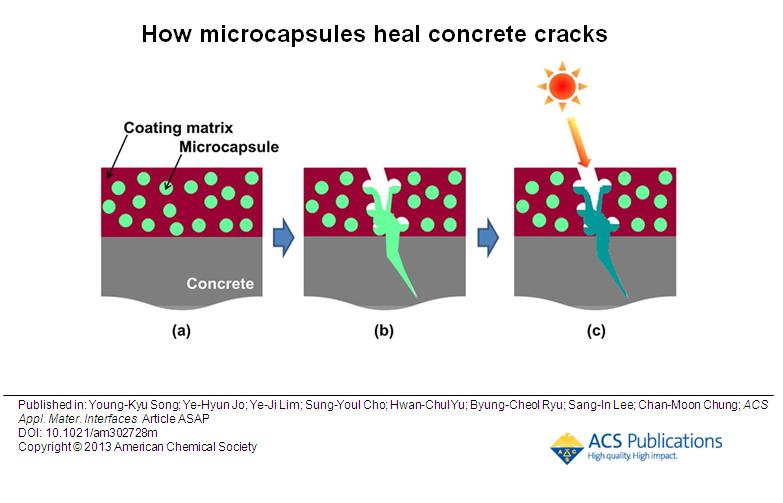Editor’s note: This article summary, from Applied Materials & Interfaces website, for ACS Publications, and was authored by a team from the Department of Chemistry at Yonsei University in Korea, and the Korea Conformity Lab. This might be of interest to those who spec concrete in wind turbine foundations, in particular those poured in climates with frequent freeze-thaw cycles. The full article is here: http://pubs.acs.org/doi/full/10.1021/am302728m#

When concrete cracks, microcapsules would release an agent activated by UV light that solidifies the material in the capsules, thereby sealing the crack.
Microcrack formation and propagation in materials leads to significant reduction in their mechanical performance and other required properties. Recently, attention has been paid to self-healing of microcracks to extend functional lifetime of the materials. Self-healing polymers and polymer composites can be classified into categories of intrinsic or those able to heal cracks by the materials themselves, and extrinsic, those in which the healing agent is preembedded. In the case of extrinsic self-healing, matrix resin is not a healable one and a healing agent must be encapsulated and embedded into the materials in advance. As soon as the cracks destroy the microcapsules, the healing agent releases into the crack planes because of the capillary effect. This heals the cracks.
A typical extrinsic self-healing system uses a microencapsulated healing agent and a (microencapsulated) catalyst. When microcracks propagate through the matrix, the healing agent is released from ruptured microcapsules and polymerizes on contact with the catalyst to repair the damaged region. However, there are limitations to the system, including catalyst availability, cost, environmental toxicity, stability, and materials processing.
Recently catalyst-free self-healing systems has been studied to develop less expensive and more practical ways to self-repair polymeric materials. One autonomous, catalyst-free approach is self-healing under natural conditions, for example, in the presence of atmospheric moisture, and oxygen, and sunlight.
Photochemical self-healing by UV light or sunlight is a catalyst-free, environmentally friendly, inexpensive, and practical strategy. Photoinduced mending has been accomplished using cinnamates, coumarin, anthracene, and chitosan. However, all the previously reported photoinduced self-healing materials are intrinsic healing systems. There has been no report on extrinsic photoinduced self-healing system based on healing-agent-loaded microcapsules, although the microencapsulation of UV-curable silicone oligomers have been reported.(26) Compared to the intrinsic system, the extrinsic one has advantages including the ease of application in most polymer systems and healing of larger damage volume. This paper describes the first example of an extrinsic photoinduced self-healing system.
A protective coating is used to protect the surface of a material from various deterioration factors. In the case of a concrete protective coating, when cracks form and propagate in the coating, water, chloride ion, and carbon dioxide would penetrate the cracks. This deteriorates the concrete, leading to reduction in its serviceability. If the protective coating for concrete has self-healing ability, it would effectively protect the concrete surface from the deterioration. Although several reports of self-healing anticorrosive coatings for metal protection have appear, there has been no report on self-healing protective coating for concrete.
In this work the authors have developed a self-healing protective coating system for concrete in which microcracks can be repaired by UV light or sunlight. Healing-agent-loaded microcapsules are embedded in a coating matrix to obtain a self-healing protective coating. Upon damage-induced cracking, the microcapsules are ruptured by the propagating crack fronts, resulting in release of the healing agent into the crack by capillary action and then self-healing is achieved by sunlight.
Read the rest at http://pubs.acs.org/doi/full/10.1021/am302728m#
Filed Under: Construction, News





Thanks for such a great research….
If possible please send me the details of this research on my mail ID
My Mail ID: mahesh_raut777@rediffmail.com